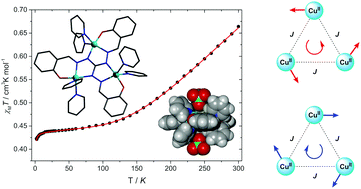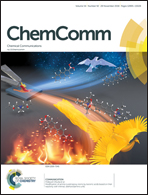Molecular electronic spin qubits from a spin-frustrated trinuclear copper complex†
Abstract
The trinuclear copper(II) complex [Cu3(saltag)(py)6]ClO4 (H5saltag = tris(2-hydroxybenzylidene)triaminoguanidine) was synthesized and characterized by experimental as well as theoretical methods. This complex exhibits a strong antiferromagnetic coupling (J = −298 cm−1) between the copper(II) ions, mediated by the N–N diazine bridges of the tritopic ligand, leading to a spin-frustrated system. This compound shows a T2 coherence time of 340 ns in frozen pyridine solution, which extends to 591 ns by changing the solvent to pyridine-d5. Hence, the presented compound is a promising candidate as a building block for molecular spintronics.



 Please wait while we load your content...
Please wait while we load your content...